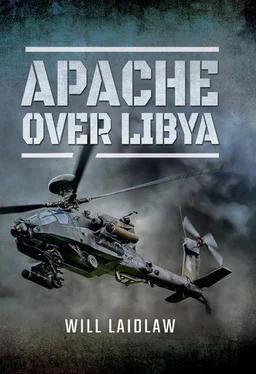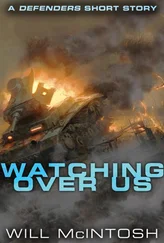I looked at the route: fly right past Gaddafi’s SF base; a long low-level transit, lower than the wires, past miles of industrial complexes; push south-east into the desert and then swing up from the south to strike the targets; then a dash at full tilt over two miles of perfect SAMbush country with little fuel and perhaps just a round or two of ammunition left; finally, go and find Ocean somewhere in the darkness at sea. After seven weeks of missions over Libya this was accepted as a normal night out. It was a ‘yes’ from me.
When it came to the mission brief, Doug and his team had already loaded our Hellfire and 30mm. The 5 thcrew had proved the systems in each aircraft, Ocean was ploughing onwards to the launch point and the weather looked good. It was now a matter of getting a ‘Go’ out of the CAOC, a ‘Go’ from the Commodore and any last-minute discussions with the CO. I highlighted the risks and indicated where aircraft could escape to the left and right of track if things unravelled. I showed the team where we could break off the mission and turn for home. I discussed the likely enemy response at every phase – his weapons, how he might use them and how we would respond. Finally, I detailed the target, dividing up responsibilities between the two aircraft, describing which weapons were to be used and in what order. We checked our understanding of radio frequencies, heights and speeds to be flown, attack headings and the sequence of firing.
Finally, we confirmed with each pilot what his actions would be if the worst was to happen over either sea or land – a forced landing due to mechanical malfunction or enemy fire. The 56 thRescue crews, callsign ‘Jolly’, were always keen to listen to this part, and their mission commander would note all routes, radio frequencies and likely escape and rendezvous points. They would sit in the Operations Room throughout the mission, ready to launch when needed. In rehearsals and exercises, which they continually conducted, the Jollys proved they could get two HH60s packed with PJs [7] Pararescuemen
and medical kit off the deck and on mission within seven minutes of being notified in the Operations Room. From the day they arrived on board we flew reassured that determined, courageous and experienced combat operators stood ready to come and get us if the call was made.
There was a lot activity in the target area that night. The usual fast air missions were going in all around the country, but there was also naval gunfire to the east of Zlitan, not too far away from our target. As part of her mission, HMS Liverpool would be firing illumination rounds that hang in the sky under parachutes, turning dark into light for miles around. Acknowledging our need for darkness and their need for light, our missions were scheduled to take place at different times – mine some twenty minutes after the naval gunfire was complete.
At the conclusion of the mission brief, we heard it was a ‘Go’ from the CAOC – targets good, support aircraft on task.
And then the ritual begins: the transition from planner and risk-mitigator to man about to rush into the fight and pull the trigger again. I would lean on the railings of the quarterdeck in the early evening light with a cup of tea. It was always too hot at the start and the wrong side of cool at the end, and every time I would tip away the dregs and watch the falling liquid separate out into mist and settle in the ship’s wake as we ploughed steadily forward to our launch point. This was my least favourite time in the day. I was always nervous. Waiting was difficult.
With the tea done, I’d head for my cabin and close the door behind me. There I’d sanitize my clothing, removing badges of rank and identity, ensuring my escape map was in my pocket, that I had a tourniquet in my upper arm pocket and another one in my thigh pocket. No money, no wallet, no photos, no letters, nothing that made me anything other than just a man in a military uniform. The last thing I’d do was touch a photograph of my girls. It was summer where they were too. Summer and smiles and hats and dresses, sitting on a picnic rug on the lawn in the garden, dog asleep on the right-hand side – K had sent me out a collage of happiness. I would turn away and swallow down the fear.
Then I was ready. On leaving my cabin I had made the transition. We sometimes refer to this as being in your ‘mission bubble’. We get used to it from our earliest sorties on the Army Pilots’ Course. Aircrew need their own space for mental preparation. They need to organize their thoughts and rehearse in their mind how they wish the sortie to go. On the Pilots’ Course test sorties are always nervous affairs, and those who complete the course and then complete the equally demanding Apache Conversion Course know very well the pressure of testing sorties and develop their own individual coping mechanisms to deal with that pressure. Once in a Regiment, there are six-monthly check rides and periodic sorties with Aviation Standards to keep you going. My coping ritual was a product of that evolution, but it now had the additional concern of the very real prospect of perishing within the next two hours.
My next stop was back in the flip-flop. Signatures were exchanged for a Sig Saur 9mm pistol, a 5.56mm L22 A2 Carbine assault rifle and two morphine syrettes. The morphine was placed next to each tourniquet in their respective pockets, my logic being that come the moment of injury and the need for self-aid I would have some chance of locating a tourniquet and some morphine if they were kept together. John had already passed this stage on his way to signing out the aircraft, conducting the walk-round and flashing up the systems.
I had one more moment of professional consideration. About an hour before launching each mission the Commodore held a Go/No Go Brief. The mission, the Rules of Engagement, the threat, the ship’s systems and the weather were all discussed, and the last word prior to the Commodore’s decision would be the view from his Policy Adviser, a sharp mind from the Civil Service with a direct line into the top of Downing Street. He would give an informed opinion as to where this mission sat in the strategic political context of the whole operation and advise how the intended course of action contributed to that political end and how it was compliant with the ministerial submission that bounded our activity.
It was declared a ‘Go’. All we had to do now was fly it!
That final Go/No Go Brief was the last dispassionate check of our planning. I would stand to the rear or to one side, as discreetly as possible, aware that people would be looking at me but not wanting to be seen. I would be nervous, because now I wanted to get on with it: get in the aircraft, listen to the radios, build a picture in my mind, test and check the systems, count down, launch, go and get the task done, avoid coming unstuck. I always did my best to look quiet, appear a picture of focused professionalism. But a closer look would have noticed that my toes were folding and unfolding in my boots, my teeth were slowly grinding together; I was out there, my mind was rehearsing the fight, my body was readying to deal with the fear and all I wanted to do was get out and get on with it.
With a final ‘Go’ from the Commodore, the command team from the ship and the battle staff would take their places in the Operations Room. I would check that nothing had changed, the target was still valid, there was no new information and the Rules of Engagement were still good. Then I’d grab my kit and walk to the flight deck.
It’s a long walk through passageways and up ladders to get from the Operations Room to aircrew lockers and out on to the flight deck. On my way I would pick up my go-bag – a shoulder bag full of ammunition for the Sig and the Carbine, some water and other survival items I might need should I end up on the ground in Libya. Evidence from combat experiences of aircraft landing or crashing in a hostile environment is that what is attached to the pilot will leave the aircraft with him; what is not may well get left behind in the chaos of the moment. Aircrew wear a load-carrying vest which houses some survival equipment, a radio, a GPS, a rescue strop; it also holds our body armour. On to this I attached my own breakout knife, my Sig and as much ammunition for the Sig and Carbine as I could find room for. My final port of call was the engineering space, where the REME quietly managed the paperwork and coordination of engineering in a darkened environment. John had already signed for the aircraft and I could hear it running on the auxiliary power unit on the flight deck outside. I would check the paperwork, make an appreciation of the aircraft weight and centre of gravity, its engine performance estimates and its weapon calibration, and note any engineering limitations. A brief word of thanks to the crew chief, then in went my in-ear protection, on went my flydanner [8] A head cover that makes the flying helmet more comfortable
followed by my helmet, and I was off through the airlock and out on to the dark, hot flight deck. Typically, the senior ground crew sergeant was on hand overseeing our arming and refuelling on the darkened deck. He would also shake my hand and say, ‘Have a good one, boss’ as I stepped up to the aircraft. I’d nod, smile, count the remaining lashings holding the aircraft to the flight deck, have a quick check of the missiles and then climb inside the front seat. The front seat of the front aircraft; there is nowhere else to command an Apache squadron from.
Читать дальше












